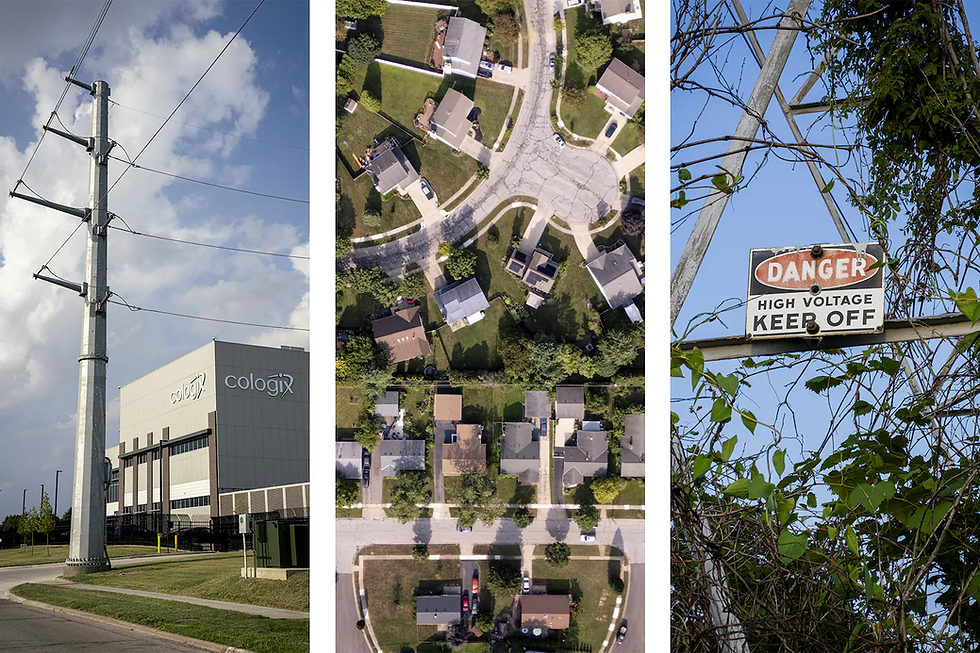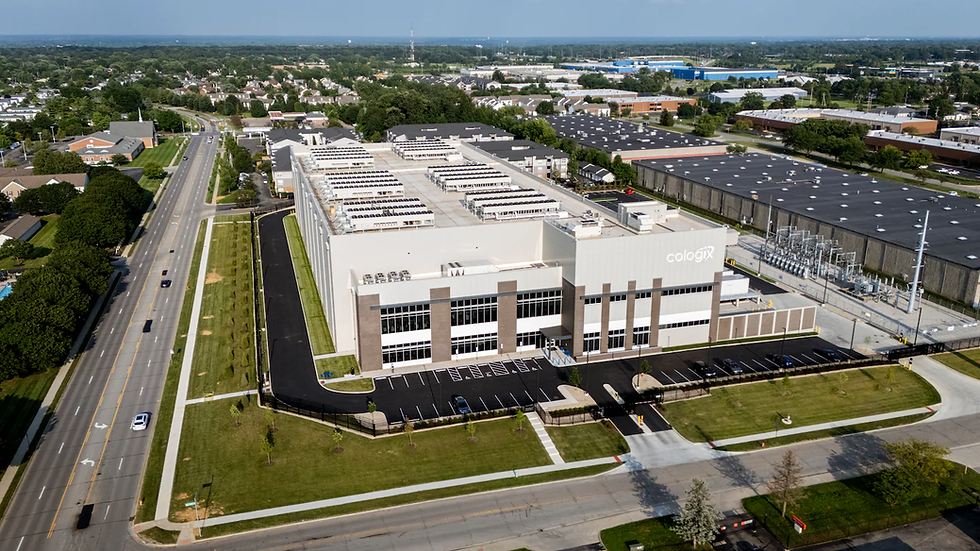The AI explosion means millions are paying more for electricity
- Think Big
- Jul 26
- 6 min read
Updated: Aug 6
The data centers required for Big Tech are driving up electricity demand — and prices.

This summer, across a vast stretch of the eastern United States, monthly home electric bills jumped. In Trenton, New Jersey, the bill for a typical home rose $26. In Philadelphia, it increased about $17. In Pittsburgh, it went up $10. And in Columbus, Ohio, it spiked $27.
Few customers were happy, of course, but even fewer knew exactly why the rates had climbed so quickly.
“I never know why it goes up,” said Vicki Miller, a retired secretary in Columbus. “But I can adjust the thermostat to save money — I freeze in the winter and roast in the summer.”
This time around, though, it is possible to trace the price hikes in these cities to a specific source: the boom in data centers, those large warehouses of technology that support artificial intelligence, cloud computing and other Big Tech wonders. They consume huge amounts of electricity, and, as they proliferate, the surging demand for electricity has driven up prices for millions of people, including residential customers who may not ever use AI or cloud computing.
In Columbus, for example, households on the standard plan of the local utility began paying about $20 more a month as of June — or $240 a year — because of the demand from data centers, according to a calculation based on figures from an independent monitor overseeing the region’s energy auctions and the local utility, AEP Ohio.
The ranks of the companies building the data centers — Google, Meta, Microsoft and Amazon — include some of the nation’s biggest and most prosperous companies, and many affected residents resent having to pay more because of the tech companies’ rising electricity demand. (Amazon founder Jeff Bezos owns The Washington Post.)
“It’s definitely not fair,” said Alicia Tolbert of Columbus. She does merchandising for department stores, and her husband is a truck driver. “I really can’t afford it.”
“The Big Tech companies suck up the electricity, and we end up paying higher prices,” said Carrie Killingsworth, who works in financial services. “I’m not comfortable with average customers subsidizing billion-dollar companies.”


As data centers pop up across the U.S., energy experts fear their growing needs for power will outstrip supply and the prices will spike for everyone. For years, they have supported an array of e-commerce sites, social media and online video platforms, and the addition of AI applications is now boosting their power usage.
“We are seeing every region of the country experience really significant data center load growth,” said Abe Silverman, a nonresident research scholar focused on energy markets at Johns Hopkins University. “It’s putting enormous upward pressure on prices, both for transmission and for generation.”
Earlier this month, energy regulators in Ohio ruled that data centers must pay more for the upgrades to the grid needed to serve data centers, overruling the objections of the tech companies, who said they were being targeted unfairly. In an emailed statement afterward, industry group the Data Center Coalition said that it was “very disappointed” in the decision.
In a statement for this article, the Data Center Coalition said the industry “is committed to paying its full cost of service for the energy it uses.”
The markets for electricity are complex, and blaming one factor or another for residential price hikes can be complicated — but not when it comes to data centers and this summer’s rising home bills in several cities.
Take Columbus. In announcing that the average residential bill would rise this year by about $27 a month, the local utility AEP indicated that the increase was due to how much the company had to pay for “capacity” — that is, how much AEP had to pay to make sure the utility had enough power available to handle days of peak demand.
The price for capacity is set every year during an auction in which utilities spanning 13 states and D.C. bid on the capacity generated by power companies. Last year, capacity prices in this auction rose a staggering 833 percent, and those increases are flowing into residential bills in the affected states.
Although it was not initially clear why the capacity price rose so quickly, a little-noticed report issued in June identified the cause. According to the independent monitor hired to analyze the electricity market known as PJM, about three-quarters of the jump stemmed from the demand from existing and planned data centers.
“There has been a paradigm shift in the market,” Joseph Bowring, the author of the independent monitor’s report, said in an interview. “These data centers could overwhelm the grid. The system cannot go on this way.”

Indeed, this year’s auction, which concluded earlier this month, increased capacity prices yet again — by about 22 percent. This increase does not mean residential bills will automatically jump by that amount, however, because the capacity prices are just one portion of an electric bill, and in Ohio and some other states, residents typically can choose from a number of electricity providers.
Generally speaking, though, the recent increase is passed through to customers and will tend to push residential bills upward in the 13 states where utilities participate in the capacity market: Delaware, Illinois, Indiana, Kentucky, Maryland, Michigan, New Jersey, North Carolina, Ohio, Pennsylvania, Tennessee, Virginia and West Virginia.
As AI and other innovations continue to dazzle the public and become an increasingly important part of the economy, the data center boom has spread across the United States. Politicians and tech backers, moreover, have touted the facilities as a source of jobs, and several states have offered tax breaks to attract the facilities.

Virginia, for example, is home to more data centers than any other state and has offered an exemption to the state’s retail sales and use tax to attract large-scale data centers. The exemption allows data centers and their tenants to purchase computers and other equipment, such as servers, without paying sales tax. Ohio also offers data centers a sales tax exemption.
“Data centers are the essential digital infrastructure behind every online purchase, every telehealth appointment, every online news article and every digital classroom,” the Data Center Coalition’s vice president of energy, Aaron Tinjum, said in a statement. “Data centers enable the essential services and cutting-edge technologies that drive our economy and enhance our quality of life, ensuring that our homes, businesses, schools, hospitals, manufacturing facilities and government units operate smoothly and efficiently.”
Even some of the residents affected by the rising electricity prices look favorably on the data centers.
Dan Longerbone, a bus driver in the Columbus area, said the rising costs have led him to be very careful about his electricity use — he’s installed LED lights, and in the summer, he turns up the thermostat. Yet he values the economic benefits of the data centers.
“They do bring jobs,” he said of those he’s seen in the area. “They don’t hurt anybody. They just sit by themselves. They do their thing.”


The data centers, however, often are rising in quiet rural or exurban areas, where neighbors complain of the noise and of their water demands. With the increased demand for energy, the rise in power plants is expected to increase carbon emissions and climate risks.
As the data centers push up electricity bills, however, their proliferation seems likely to anger an even larger swath of the public, even if many are unaware of their own role in creating more demand for electricity.
While AI applications like ChatGPT are quick and easy to use, even simple AI tasks can require large amounts of electricity. For example, generating a high-definition image using an AI model takes as much energy as charging a smartphone to halfway, according to a study by researchers at Hugging Face, a tech platform for AI, and Carnegie Mellon University.
People using the AI apps don’t realize how much energy they require, said Sasha Luccioni, one of the researchers.
“There is a disconnect,” she said. “We talk about ‘the cloud’ as if it were immaterial. People using these applications don’t imagine a data center — a four-story building as big as a football field.”





Comments